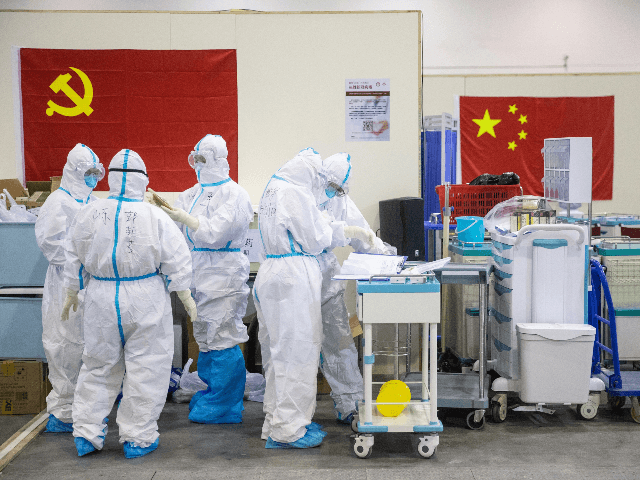The Communist Party of China triumphantly proclaimed on Thursday that it had logged its first day without a single domestic Wuhan coronavirus infection, earning the applause of gullible mainstream media outlets and its puppets at the World Health Organization (WHO).
Those celebrating, in addition to disregarding the clear signs that the claim may not be true – like reports of Wuhan hospitals turning away residents with coronavirus symptoms, or a suspicious increase in “pneumonia” death certificates at funeral homes not counted as coronavirus – have failed to note that China made a significant change in how it counted coronavirus cases in February.
That month, the National Health Commission ordered doctors not to count individuals confirmed to be infected with the Wuhan coronavirus, but exhibiting no or “mild” symptoms, in the official count of coronavirus cases.
“The changes to the classification of asymptomatic coronavirus cases emerged on Jan. 29, in a set of guidance from China’s National Health Commission,” the New York Times reported in mid-February. “Health officials said that they would reclassify patients who had tested positive for the new coronavirus but did not have symptoms, and take them out of the total count of confirmed cases.”
The Times noted that China had “closely guarded the demographic details about the fatalities, creating uncertainty about who is most susceptible.”
The National Health Commission did not define what a “mild” coronavirus case looks like, in contrast to severe cases that would count in China’s official tally. A study published in China two weeks later found that as many as 80 percent of coronavirus cases are “mild,” suggesting that Beijing had suddenly decided to document only 20 percent of its coronavirus cases, if using the same standard that the Chinese researchers did.
The Wuhan coronavirus, like other types of coronaviruses, often causes dry cough, fever, and body aches. In severe cases, patients experience difficulty breathing that becomes a potentially deadly pneumonia. Older people and those with other adverse health conditions of immunological weakness are at higher risk to experience more severe symptoms.
Scientists believe a yet-unknown percentage of people do not experience any symptoms at all and thus do not know they are contagious, leading to widespread global demands for people to stay home and avoid contact with others regardless of how they feel to prevent unknowingly spreading the virus.
In the aftermath of China’s decision to not count as many as four out of five cases of coronavirus in the country, scientists warned that doing so could make it significantly difficult for researchers to study and understand how the virus spreads, thus also learning how to stop it.
The decision calls into question China’s “milestone” announcement of no new cases, one of several proclamations of victory from the Chinese Communist Party. In January, about a week after telling the world the novel coronavirus existed, Beijing claimed a miraculous drop in the number of cases in Wuhan, the central metropolis where the virus originated.
“Tuesday brought a gleam of hope for China as at least 10 provinces, including Central China’s Hubei Province, the epicenter of the coronavirus outbreak, reported a decline in the number of newly infected patients than the previous day,” the state propaganda newspaper Global Times declared on January 29.
At the beginning of March, the Global Times quoted Communist Party “experts” predicting China would see no new cases by the end of the month and a full return to normalcy by the end of April. Following that report were allegations from within Wuhan that the Chinese state was actively repressing case reporting, just as Xi Jinping finally visited Wuhan and the World Health Organization (WHO), a day after Xi declared the outbreak over, identified the Wuhan virus outbreak as a global pandemic.
The Epoch Times, speaking to anonymous Wuhan residents, reported several instances of individuals seeking health care because of symptoms like coughs and fevers but finding no hospital willing to take them. Funeral home directors also reported an increase in the number of bodies they received with certificates identifying their causes of death as “pneumonia,” but not mentioning a potential coronavirus diagnosis.
American National Security Advisor Robert O’Brien accused China of wasting two months of the world’s time by attempting to hide the true scale of the outbreak in remarks this month.
“Unfortunately, rather than using best practices, this outbreak in Wuhan was covered up,” O’Brien said in remarks at the Heritage Foundation. “It probably cost the world community two months to respond … [where] we could have dramatically curtailed what happened in China and what’s now happening across the world.”
China claims 81,250 cases of Chinese coronavirus nationwide at presstime, among them 3,253 deaths, the overwhelming majority in Hubei province. Wuhan is the regional capital of Hubei.

COMMENTS
Please let us know if you're having issues with commenting.